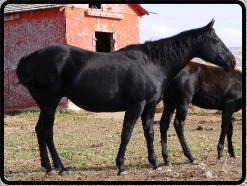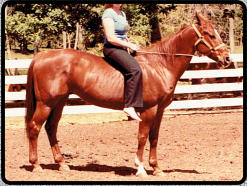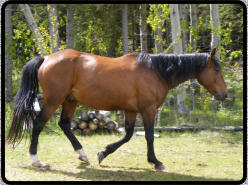
Website created by Prairie Silver Quarter Horses © 2021. Please contact us for permission to use our content or images
Coat Colour Genetics

Next Page
Page 1









Introduction
It seems that it used to be pretty easy to tell someone the coat colour of your horse - it was probably Black or Sorrel or Bay with the odd Palomino thrown in. The
most confusing it was likely to get was calling a white horse ‘Grey’, or perhaps the difference between a Sorrel and a Chestnut (there really is none). A few years
back, some new and exciting colours started showing up on the horse scene and people began talking about Grulla, Blue Roan, and others.
And then along came DNA testing that identified various colour modifiers - called alleles - which broadened the spectrum even further. ‘White’ horses can suddenly
be Cremello or Perlino; Brown horses might really be Smoky Black; and what the heck is a Classic Cream Champagne Dun, anyway?
This presentation is aimed at unraveling a little of the complications in today’s equine coat colours. It should be noted that, because DNA coat testing is a recent
technology, many of these newly identified colours are not yet recognized by some Breed Registries. For example, AQHA only recognizes 17 different colours; so if
you own a Gold Champagne quarter horse, it will still be registered as a Palomino.
In a hurry or don’t like a lot of reading? Skip to:
Heterozygous/Homozygous | Agouti | Seal Brown | Cream | Champagne | Dun Factor (Dun) | Silver | Flaxen | Grey | Roan
Colour Combinations | Coat Calculators | Quick Reference
Still here? Okay, let’s carry on…
Basic Genetics
Truth is, until genetics testing came along, no one generally knew the difference between two horses that ‘look’ the same colour, even though they may have
actually arrived there through very different gene paths. This may not be that important to the average horse owner, who is mostly concerned with how his horse
looks – but for breeders trying to duplicate that colour in their next foal crop, knowing HOW it happened becomes critically important.To explain, we first have to
go back to our high school science class. Does anyone remember Mendel’s Law?
Every characteristic of every living thing is determined by its genes - including a horse’s colour (actually, they’re called gene ‘alleles’, but for the sake of sanity,
let’s not worry about that now). Genes always occur in pairs – for example a foal’s coat colour will be determined by receiving ONE gene from the father and ONE
from the mother, to make up its own individual gene PAIR. Usually there are two basic variations of a particular gene. The stronger or ‘Dominant’ gene is identified
using a capital letter; while the weaker or ‘Recessive’ gene is written as a small letter. If this is too confusing, just think of it as There or NOT There. So a Capital
letter means it’s There and a small letter means it’s Not There. For example, the allele for Black is represented by the letter ‘e’. Capital ‘E’ means the horse has a
Black gene, and a small ‘e’ means it doesn’t.
Getting back to Mendel’s Law… Mendel basically said that since both parents each contribute one of their genes and they have two to choose from - mathematically,
this means that the offspring can receive one of four possible combinations: Sire: AB (gene pair) plus Dam: CD (gene pair) = A+C or A+D or B+C or B+D
Remember, you can’t pass something on unless you have in the first place, so a capital letter (Dominant) means that particular characteristic passes to the foal and
a small letter (Recessive) means it didn’t get passed on to the foal. When one parent passes a Dominant gene to a foal and the other passes a Recessive gene of the
same kind, then the Dominant one will always win (hence the moniker ‘Dominant’). So! using Black as our example, a foal who receives a gene pair of ‘E and E’ will
look Black, ‘Ee’ will look Black and - you guessed it – ‘eE’ will also mean a Black coat colour on the foal. Only when the gene pair is ‘ee’ (Not There TWICE) is the
horse going to look NOT Black, in other words... Red; commonly known in the horse world as a Sorrel or Chestnut horse.
Heterozygous/Homozygous – Let’s start with ‘Heterozygous’. This is a big fancy word that simply means that you have ONE Dominant allele within a Gene
Pair and the other, by default, is Recessive. ‘Homozygous’ indicates there are TWO Dominants in that Gene Pair, in other words, two of the same kind. This becomes
important to breeders because (using Mendel’s Law again) it allows us to predict, on a percentage basis, what the Sire and Dam can pass on to their foals. For
example, let’s say we have two Black stallions – Sire #1 is Heterozygous Black (Ee) and Sire #2 is Homozygous Black (EE). If we breed each of them to mares that are
Heterozygous for Black (Ee), Mendel says there will be 4 possible results :
Sire #1: Ee + Mare #1: Ee = E+E, E+e, e+E or e+e which gives us 3 chances of Black (75%) and 1 chance of Sorrel (25%)
Sire #2: EE + Mare #2: Ee = E+E, E+e, E+E or E+e which means that in all 4 cases the foal will be Black.
So, for a breeder to produce ONLY Black offspring, one or both of the parents (in this case Sire #2) must be HOMOZYGOUS. This general principle applies to all the
other colour alleles as well, allowing breeders to make educated decisions on what colour of Sire and Dam will produce which colour of offspring… Gotta love DNA
colour testing!!
Basic Horse Colours
Thus, there are two basic or ‘base’ colours a horse can be – Black or Red. But wait! you say…
what about all those Bays out there, they’re black AND red! Actually, no… at least… not
genetically speaking. A Bay horse, one of the most common colours seen these days, is a Black
horse with an additional colour allele called ‘Agouti’ - more about Agouti in a minute. Through
the eons, colour genes have formed natural mutations which can modify or change the original
base colour of a horse in a variety of ways. Each of these mutations has a name, and many
alleles can now be detected through DNA testing to see if they are There or Not.
To understand the influence these mutations may have on the visual aspect of a horse’s coat,
we need to first identify the difference between the horse’s ‘points’ and his ‘body’. Why? Because some colour alleles influence only the points, some only the body
and some affect both. The ‘Points’ include: the lower legs from knee down; the mane and tail; the tips of the ears; and (sometimes) the head - in other words, all
the extremities of the animal. The ‘Body’ is pretty much everything else in the center.
Now that we have that out of the way, let’s take a look at Agouti, which is, historically, most likely one of the first mutations to develop. In fact, it’s so old, it’s
mutated a couple of times itself – but we can talk about that a little later.
Agouti (a-goo’-tee)
Agouti only affects BLACK hair – and it only affects the BODY of the horse. Agouti restricts or prevents the black pigment from
showing up - therefore the hair on the Body of the horse will look red. Take your typical ‘Bay’ horse, for example; a Bay is a Black
horse with Agouti (Black + Agouti). That’s why a Bay has black Points (lower legs, mane, tail, etc) but a red Body (I find it easiest
to think of the Agouti as ‘erasing’ the black pigment, even though this is not strictly correct, of course).
It’s worth mentioning that a Sorrel (red) horse may also carry the Agouti allele, but since there’s no black hair to ‘erase’ then
there’s no way to tell by just looking. DNA colour testing would give you the answer. By the way, the letter representing Agouti is
‘A’, with a capital letter indicating its presence (dominant) and a small ‘a’ representing its absence (recessive).
So, at this point we now have two base colours, Black and Red; and three basic colours for our horses: Black (black), Sorrel (red) and Bay (black + agouti). These
three provide the basis for every other colour variation out there - combined with a few new mutations, of course. Moving onward…











